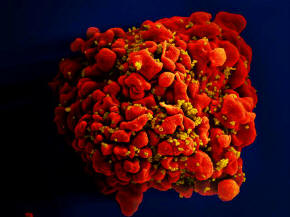Oldest patient yet cured of HIV after stem cell transplant – researchers
 Send a link to a friend
Send a link to a friend
 [July 28, 2022]
By Jennifer Rigby [July 28, 2022]
By Jennifer Rigby
LONDON (Reuters) -The oldest patient yet
has been cured of HIV after receiving a stem cell transplant for
leukaemia, researchers reported on Wednesday.
While the transplant was planned to treat the now-66-year-old's
leukaemia, the doctors also sought a donor who was naturally resistant
to the virus that causes AIDS, a mechanism that first worked to cure the
"Berlin patient", Timothy Ray Brown, in 2007.
The latest patient, the fourth to be cured in this way, is known as the
"City of Hope" patient after the U.S. facility in Duarte, California,
where he was treated, because he does not want to be identified.
As well as being the oldest, the patient has also had HIV the longest,
having been diagnosed in 1988 with what he described as a "death
sentence" that killed many of his friends.
He has been on antiretroviral therapy (ART) to control his condition for
more than 30 years.

Doctors who presented the data ahead of the International Aids Society's
(IAS) 2022 meeting said the case opened up the potential for older
patients with HIV and blood cancer to access the treatment, particularly
as the stem cell donor was not a family member.
HOPE
Describing a cure as the "holy grail", Sharon Lewin, president-elect of
the IAS, said the case provided "continued hope ... and inspiration" for
people with HIV and the wider scientific community, although it was
unlikely to be an option for most people with HIV due to the risks of
the procedure.
[to top of second column]
|

A digitally colorized scanning electron microscopic image depicts a
single, red colored H9-T cell that had been infected by numerous,
spheroid shaped, mustard colored human immunodeficiency virus (HIV)
particles attached to the cell's surface membrane. Courtesy NIAID
 Scientists think the process works
because the donor individual's stem cells have a specific, rare
genetic mutation which means they lack the receptors used by HIV to
infect cells.
After the transplant three and a half years ago,
which followed chemotherapy, the City of Hope patient stopped taking
ART in March 2021. He has now been in remission from both HIV and
leukaemia for more than a year, the team said.
On Wednesday, researchers in Spain also presented details of a
59-year-old woman who is one of a rare group of what is known as
"post-treatment controllers". They can maintain undetectable viral
loads after stopping ART, and also provide clues to a potential
cure, Lewin said.
Ahead of the IAS conference that starts on Friday, the Joint United
Nations Programme on HIV/AIDS (UNAIDS) also presented data showing
how the COVID-19 pandemic had derailed global efforts to tackle HIV,
including a reversal of progress in the world's most populous
region, Asia and the Pacific.
(Reporting by Jennifer Rigby;Editing by Alison Williams and Gareth
Jones)
[© 2022 Thomson Reuters. All rights
reserved.] This material may not be published,
broadcast, rewritten or redistributed.
Thompson Reuters is solely responsible for this content.
 |